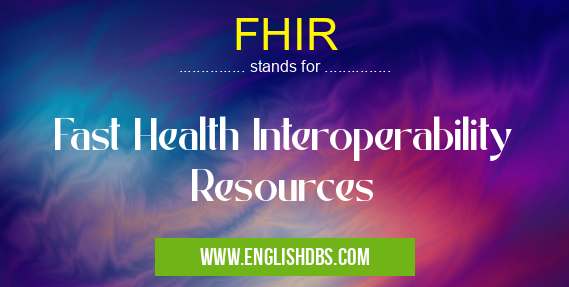What does FHIR mean in HEALTHCARE
FHIR stands for Fast Health Interoperability Resources. It is a standard for exchanging healthcare information electronically. FHIR was developed by Health Level Seven International (HL7), a non-profit organization that develops standards for healthcare information exchange.

FHIR meaning in Healthcare in Medical
FHIR mostly used in an acronym Healthcare in Category Medical that means Fast Health Interoperability Resources
Shorthand: FHIR,
Full Form: Fast Health Interoperability Resources
For more information of "Fast Health Interoperability Resources", see the section below.
» Medical » Healthcare
FHIR is a modern, flexible, and extensible standard that is designed to meet the needs of a variety of healthcare applications. It is based on the RESTful architecture style, which is a common approach to developing web services. FHIR resources are represented as JSON or XML documents, and they can be exchanged using HTTP requests and responses.
Key Features of FHIR
- Easy to use: FHIR is designed to be easy to use for developers and implementers. It provides a simple and consistent way to represent healthcare data, and it supports a variety of common healthcare data types.
- Flexible: FHIR is a flexible standard that can be used to represent a wide variety of healthcare data. It can be used to represent clinical data, administrative data, and financial data.
- Extensible: FHIR is an extensible standard that can be customized to meet the needs of specific healthcare applications. Developers can create their own FHIR resources and profiles to represent data that is not covered by the standard FHIR resources.
Benefits of Using FHIR
- Improved interoperability: FHIR can help to improve interoperability between different healthcare systems. By using FHIR, healthcare providers can exchange data more easily and efficiently.
- Reduced costs: FHIR can help to reduce the costs of healthcare information exchange. By using a standard format for data exchange, healthcare providers can avoid the need to develop custom interfaces and data mapping tools.
- Improved patient care: FHIR can help to improve patient care by providing healthcare providers with access to more complete and accurate information about their patients.
Essential Questions and Answers on Fast Health Interoperability Resources in "MEDICAL»HEALTHCARE"
What is FHIR?
FHIR (Fast Health Interoperability Resources) is a standard for exchanging healthcare information electronically. It is designed to make it easier for different healthcare systems to communicate with each other, regardless of their size or complexity.
Why is FHIR important?
FHIR is important because it provides a common language for healthcare data. This makes it easier for healthcare providers to share information with each other, which can lead to better patient care. FHIR is also important because it is flexible and extensible, which means that it can be used to represent a wide range of healthcare data.
How is FHIR used?
FHIR is used in a variety of ways, including:
- Exchanging data between different healthcare systems
- Creating new healthcare applications
- Improving the quality of healthcare data
- Supporting research
What are the benefits of using FHIR?
The benefits of using FHIR include:
- Improved interoperability between healthcare systems
- Reduced costs of data exchange
- Increased efficiency of healthcare data management
- Improved quality of healthcare data
- Support for research
How can I learn more about FHIR?
There are a number of resources available to help you learn more about FHIR, including:
- The FHIR website: https://fhir.org/
- The FHIR specification: https://fhir.org/specification/
- The FHIR community forum: https://chat.fhir.org/
Final Words: FHIR is a modern, flexible, and extensible standard for exchanging healthcare information electronically. It is designed to meet the needs of a variety of healthcare applications, and it can help to improve interoperability, reduce costs, and improve patient care.
